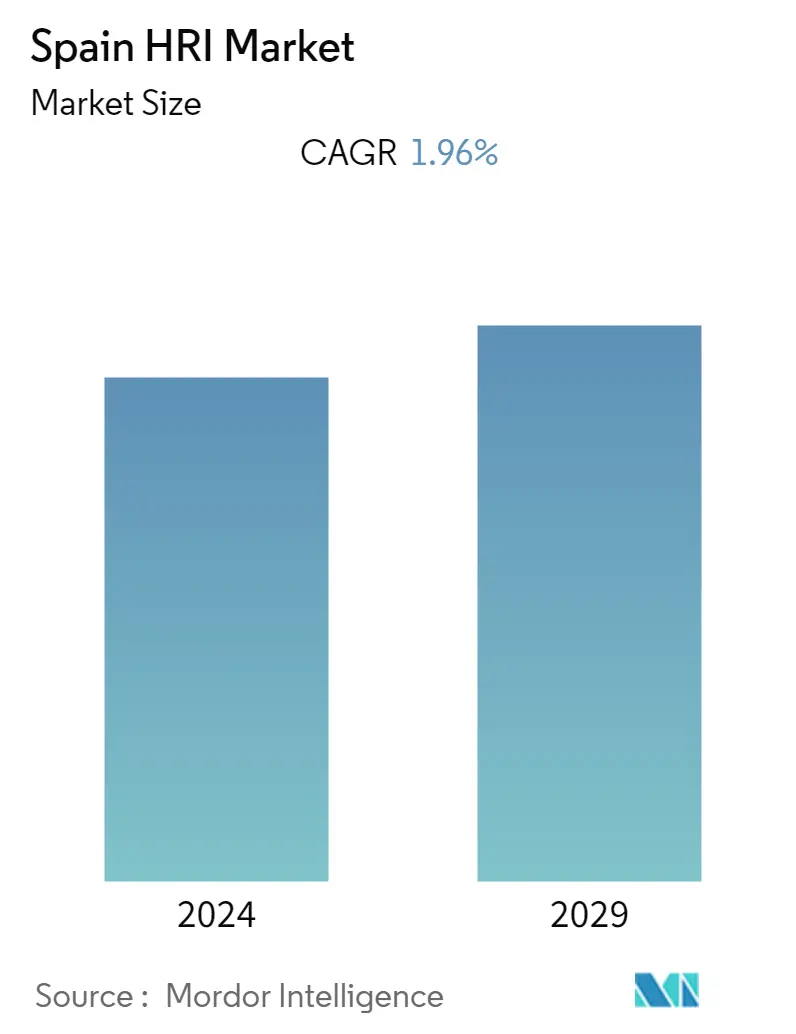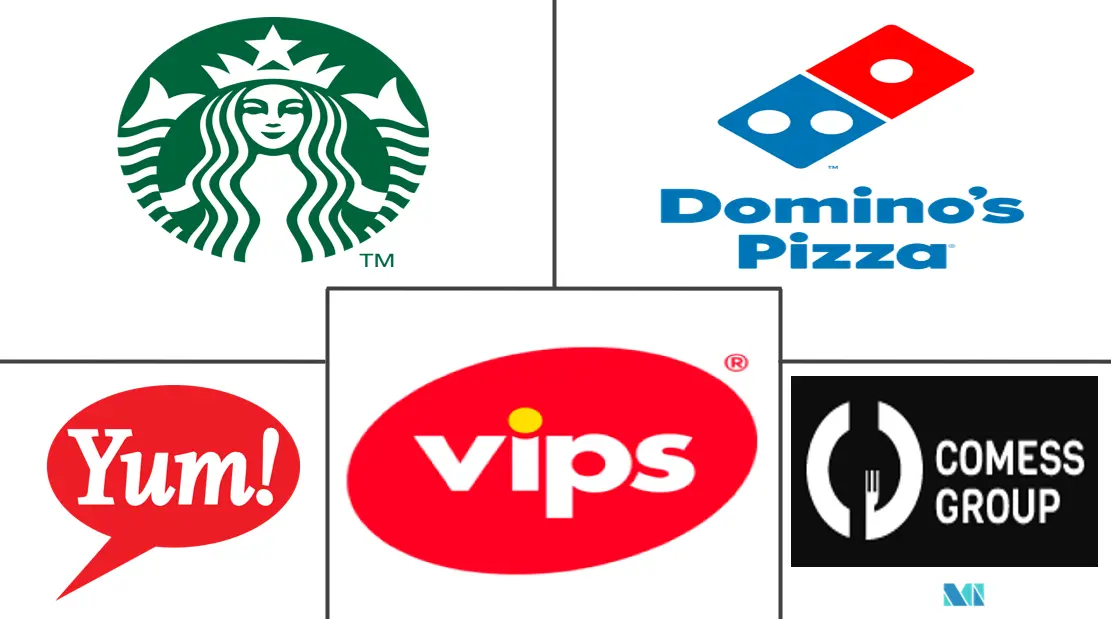Market Size of Spain HRI Industry

| Study Period | 2019 - 2029 |
| Base Year For Estimation | 2023 |
| Forecast Data Period | 2024 - 2029 |
| Historical Data Period | 2019 - 2022 |
| CAGR | 1.96 % |
| Market Concentration | Low |
Major Players
*Disclaimer: Major Players sorted in no particular order |
Spain HRI Market Analysis
The Spain HRI market is projected to grow, witnessing a CAGR of 1.96% over the next five years.
Food service brands are eying the post-millennial age group as their prime targets. The growth of the food service industry, particularly for Spanish cuisines, was largely in the small- and medium-sized cities, the potentially lucrative regions where key global brands and regional players are seeking effective market penetration. Spain is an attractive market for international food companies. There is an increase in export opportunities for the United States food and beverage suppliers, especially in the restaurant and hotel sector, due to the growing tourism sector in the country. Also, growth in the tourism sector in Spain, MICE (Meeting, Incentive, Conference, and Exhibitions) activities, and developments in the hotel and restaurant sector has further contributed to market growth. For instance, according to National Statistics Institute (INE), In February, Spain attracted 4.3 million foreign visitors, a 35.9% increase over the same period in 2022. These factors act as major driving factors for the HRI market in Spain.
Furthermore, the idea of dining and recreational experiences is becoming increasingly popular as the restaurant, café, and especially the bar industries focus on improving the customer experience. Young consumers visit these foodservice outlets in great numbers because they view them as an appropriate environment for family and social gatherings. Due to the fact that customers, particularly young people, tend to align their preferences with the most recent trends, themed restaurants, and hotels are growing in popularity as they offer unique dining experiences. The region has a good hotel market because of increasing opportunities for employment and growing population that is causing urbanization. These developments are expected to affect consumer spending in food service outlets positively, over the coming years. As a result, all the above mentioned factors drive the Spain HRI market.
Spain HRI Industry Segmentation
The HRI (Hotel, Restaurant, and Institution) food service industry is responsible for offering meals to customers. The HRI industry depends on disposable income, leisure time, and complete customer satisfaction. The scope of the Spain HRI market includes segmentation on the basis of Type and Structure. By type, the market is segmented under Consumer Foodservice, Hotels, and Institutional. The consumer foodservice segment is further segmented into Cafes and Bars, Full-service Restaurants, Fast Food, Pizza Consumer Foodservice, Self-Service Cafeterias, 100% Home Delivery/Takeaway, and Street Stalls/Kiosks. By structure, the market is segmented into Independent Outlets and Chained Outlets. For each segment, the market sizing and forecast have been done based on value (in USD million).
| Type | |||||||||
| |||||||||
| Hotels | |||||||||
| Institutional (Catering) |
| Structure | |
| Independent Outlet | |
| Chained Outlet |
Spain HRI Market Size Summary
The Spain HRI market is poised for growth, driven by a combination of factors including the burgeoning tourism sector, MICE activities, and the expansion of the hotel and restaurant industry. The market is particularly attractive to international food companies, with increasing export opportunities for U.S. food and beverage suppliers. The focus on post-millennial consumers has led to a rise in themed restaurants and hotels, which offer unique dining experiences that resonate with young consumers. This demographic shift, coupled with urbanization and a growing population, is expected to positively influence consumer spending in food service outlets. The popularity of dining and recreational experiences, especially in bars and cafes, further fuels the market's expansion.
Fast food and quick-service restaurants are significant contributors to the market's growth, driven by price consciousness and the convenience they offer. The market is characterized by a competitive and fragmented landscape, with full-service restaurants holding a major share. Key players like McDonald's, Domino's Pizza, and Burger King are leveraging strategies such as partnerships, expansions, and product innovations to enhance their market presence. The street stalls and kiosks segment also plays a crucial role, attracting tourists with affordable Spanish delicacies. The diverse and evolving food preferences among consumers create opportunities for new and foreign products, further driving the market's growth.
Spain HRI Market Size - Table of Contents
-
1. MARKET DYNAMICS
-
1.1 Market Drivers
-
1.2 Market Restraints
-
1.3 Porters 5 Force Analysis
-
1.3.1 Threat of New Entrants
-
1.3.2 Bargaining Power of Buyers/Consumers
-
1.3.3 Bargaining Power of Suppliers
-
1.3.4 Threat of Substitute Products
-
1.3.5 Intensity of Competitive Rivalry
-
-
-
2. MARKET SEGMENTATION
-
2.1 Type
-
2.1.1 Consumer Foodservice
-
2.1.1.1 Cafes and Bars
-
2.1.1.2 Full-Service Restaurants
-
2.1.1.3 Fast Food
-
2.1.1.4 Pizza Consumer Foodservice
-
2.1.1.5 Self-Service Cafeterias
-
2.1.1.6 100% Home Delivery/Takeaway
-
2.1.1.7 Street Stalls/Kiosks
-
-
2.1.2 Hotels
-
2.1.3 Institutional (Catering)
-
-
2.2 Structure
-
2.2.1 Independent Outlet
-
2.2.2 Chained Outlet
-
-
Spain HRI Market Size FAQs
What is the current Spain HRI Market size?
The Spain HRI Market is projected to register a CAGR of 1.96% during the forecast period (2024-2029)
Who are the key players in Spain HRI Market?
Starbucks Corporation, Domino's Pizza, Inc., Yum! Brands, Inc., Vips Group and Comess Group SL are the major companies operating in the Spain HRI Market.

